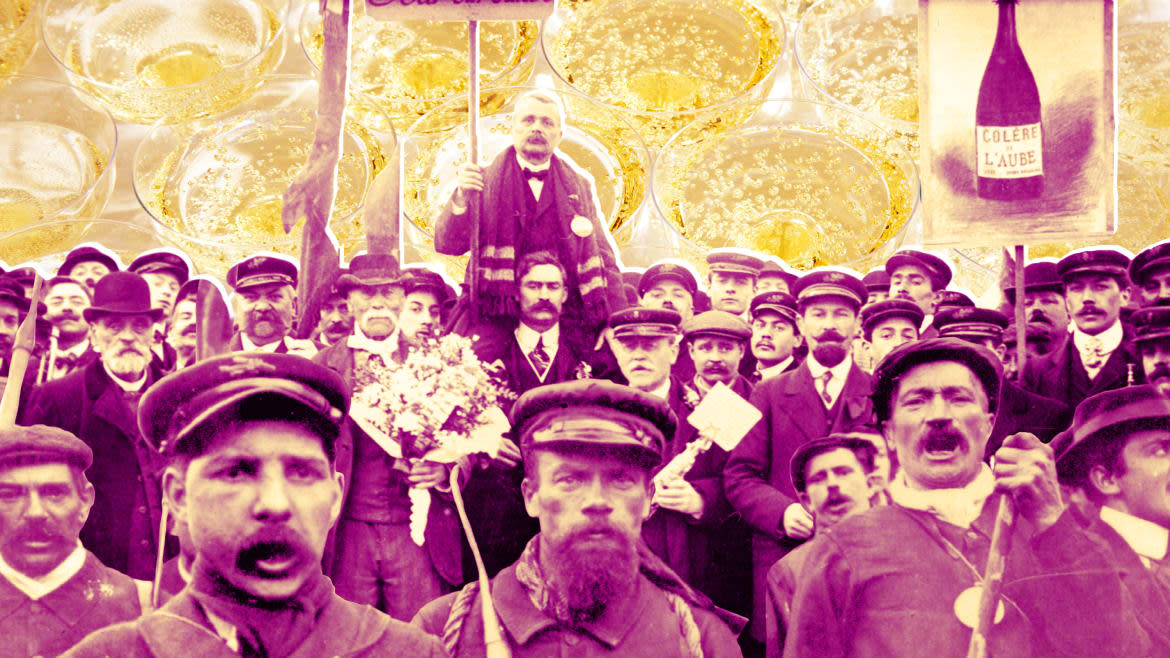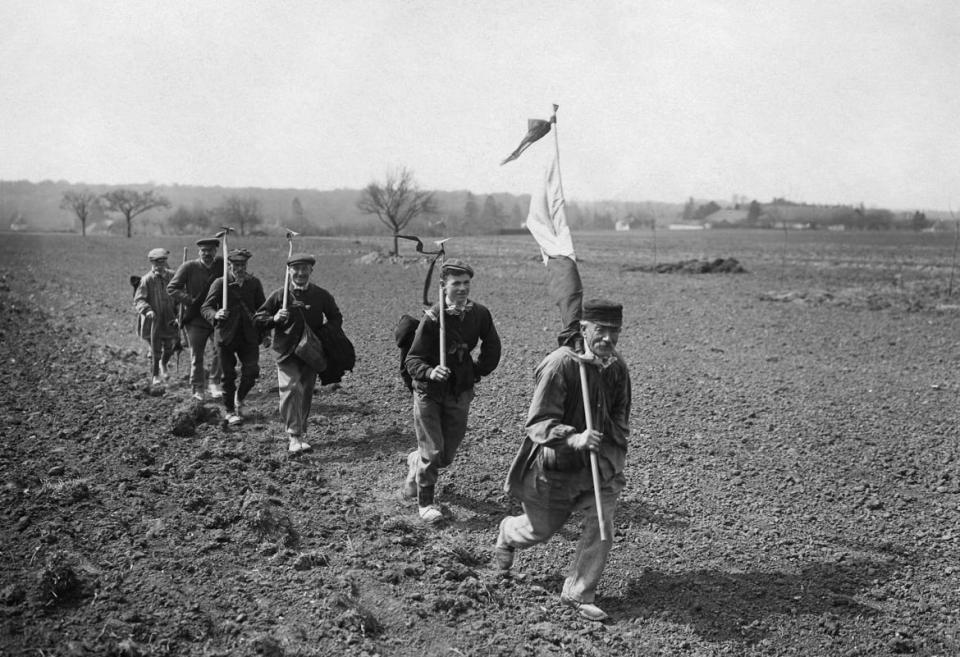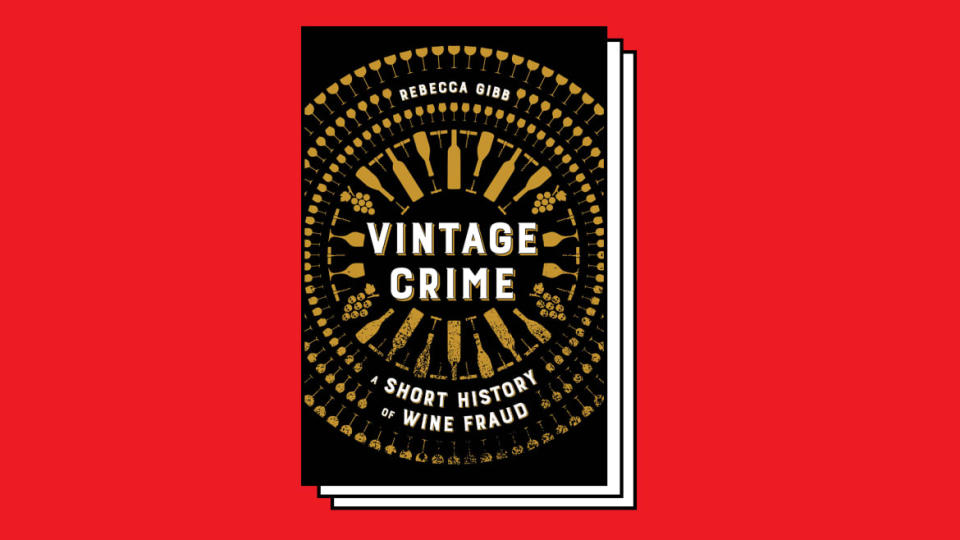When the Right to Bottle Champagne Detonated Riots

Making Champagne is now a rich man’s game, but a century ago, vineyard owners were destitute and took to the streets to demand “Death to fraudsters.” Wines from across France and beyond were shipped into local train stations, disappeared into cellars and emerged as “Champagne.” In 1911, when impoverished local grape growers took matters into their own hands, the French army was called in to restore order. But the stationing of many young soldiers in these rural villages led to one romantic encounter that would outlive the riots and two world wars. This excerpt from Vintage Crime: A Short History of Wine Fraud delves into the troubles facing the Champenois a little over a century ago.
The goal of the grape growers of the Marne was to protect the area’s winemakers from threats from without and also within. The protests have also been viewed as a cultural reaction to the first wave of globalization—the growers were drawing a boundary around their region in an attempt to consolidate their regional and national identity. This meant making laws that required all Champagne to be made from grapes grown in Champagne.
But where was Champagne? It’s a question that’s still being asked today, but in the minds of the growers of the Marne in 1911, there was no debate: the vineyards that were the true Champagne were in the Marne department. The growers of the Aube, a hundred kilometers to the south, didn’t agree, but their exclusion from the region had been on the cards for some time. In 1905, the legal basis for the creation of Champagne produced only in Champagne was set: the loi de repression des fraudes made the mislabeling of the origin of any product illegal, providing the foundation for regional appellations. In 1908, Champagne became the first wine region to be delimited. The Aube was granted a temporary stay of execution: The 1908 law required “complementary measures” to become effective, but these were not implemented by the dillydallying French government until February 1911.
The Mystery of Who Stole One of the World’s Finest Champagnes–And Where It Ended Up
It wasn’t a Marne-born Champagne grower who managed to push through the February 1911 deal for the Marnais, however. The man of the hour hailed from Marseille and had little in common with the starving growers of Champagne. Paul Bolo was a man of questionable morals: He married a rich widow and enjoyed spending her money on cars, horses, and parties. Before their wedding, he neglected to tell her he was already married, and he is said to have had many extramarital affairs with wealthy women sporting loose purse strings. The pair would entertain France’s who’s who in their Parisian mansion or Biarritz villa, and Bolo traveled widely, helping set up banks in South American republics.
By all accounts Bolo was a ladies’ man, but it wasn’t just the opposite sex that consumed his waking thoughts: as the president of the Confédération générale agricole pour la défense des produits purs (General Agricultural Confederation for the Defense of Pure Products), he came to Champagne and placed himself at the forefront of the growers’ movement. He was celebrated by the growers at the time, but his reputation was soon sullied. In 1918, he was sentenced to death and shot after the French war council found him guilty of collaborating with the Germans, having financed the purchase of a French newspaper with German money to damage morale and spread a pacifist message.

Vine-growers of the Aube region on their way to a protest.
But in the opening months of 1911, Bolo brought welcome change in the Marne. There was dancing in the streets, and bottles of Champagne were opened and enjoyed, rather than being smashed, as they would be two months later in Aÿ. The locals even played a serenade for the locally stationed troops. Newspapers proclaimed “the end of the crisis” as the Marne was declared the only true Champagne region.
However, producers in the Aube were not in a similarly celebratory mood: They had been selling their white wines to negociants in the Marne to be made into Champagne since the middle of the nineteenth century, and they believed they had a historic right to be part of this exclusive region. In his sweeping history of French wine, the late historian Marcel Lachiver explained, “They clung to the hope of being able to sell wines to the Marne negociants, even if they were resigned to the fact they couldn’t sell Champagne themselves. But the law of February 6, 1911, which stated that only wines harvested within those delimited areas could produce wines bearing the name of the appellation, destroyed this hope.”
Protests and tax strikes revealed simmering discontent in the Aube, with older members of the grape-growing community claiming that, if necessary, they were prepared to go as far as a repeat of the French Revolution of 1830: three days of violent protest that ended in the abdication of Charles X and the Bourbon monarchy. The culmination of the Aube protests was far more tranquil than it would be in Aÿ. In the streets of Troyes, 110 kilometers to the south of Aÿ, 20,000 protestors swarmed the city center, angry that the government had ordered their exclusion from the Champagne region.

Bands of men, women, and children, dirty from sleeping on the roadside en route to the protests of April 8 and 9, 1911, included Georges Collot, a grower who walked the 50-kilometer distance from the village of Urville. Collot was the grandfather of Michel Drappier, who runs Champagne Drappier, now an internationally renowned Champagne house in its own right. The family has lived in Urville since 1808, growing grapes that would be pressed and put into barrels before making their way to a Champagne negociant in Épernay or Reims by horse-drawn cart, and later by train from the station in nearby Bar-sur-Aube.
At the time of the riots, few growers in the Aube turned their grapes into wine, other than for local consumption. They left wine and Champagne production to the big companies farther north. Today, it takes more than an hour and a half to drive to Épernay from the tiny village where Michel lives and where his son, the eighth generation, will continue the family’s wine business in the years to come. “Here in the Aube, where it is so remote, people were more farmers, they were peasants. They weren’t revolutionaries. The protests in Troyes were more bonne enfant—that means rather happy, convivial. Yes, there were a few speeches, but what my grandfather told me was that the army was sent because of years of socialism, communism, trade unionism [rather than a violent uprising by the growers].”
Inspired by their figurehead Gaston Cheq, whose mustachioed bust watches over his birthplace of Bar-sur-Aube today, the Aubois growers, facing an uncertain future, shouted “Champagne or death!” The Troyes protests were peaceful—no swords were drawn and there were no reports of dead horses—but the government nevertheless found them unsettling, and eventually a compromise was offered: The region was given the right to be part of Champagne but only as a “second zone.” The possibility of the borders being redrawn to include the Aube upset their Marne counterparts to the north, who just a month earlier had been partying in the streets. This second-zone concession set the stage for the riots of April 1911, which would leave the streets of Aÿ smoldering.
The events of the first two weeks of April 1911 were a turning point for the region. The government had finally been forced to negotiate a deal that would appease both the Marnais and the Aubois temporarily. As the summer months approached, the thirst for violent protest quickly dried up and tensions eased. Further discussions around Champagne’s boundaries were left to the official bodies, while the growers returned to long days in the vineyards, hopeful of a decent crop to ease their hunger.
The army retained a presence in the region but as harvest approached, it was time for the remaining cavalry to leave Épernay and for an army of grape pickers to take their place. No longer were there more soldiers than wine growers. There were some fond farewells, according to the local newspaper, between the troops and the young women of these normally sleepy villages where romance had been sparked.
Many of those stationed in these communities had been welcomed with open arms, and one soldier did remain: In a story of love conquering all, Brittany native Sergeant Pierre Bosser was stationed in the village of Haut-villers in early 1911 as part of the government’s attempts to maintain order in the region. A young local woman, Suzanne Dutarque, the daughter of a grower, caught his eye over a Pinot Noir vine. Bosser and Dutarque’s romance quickly developed, and the pair were married within months of the riots. Suzanne didn’t come with much of a dowry: her brother would inherit the family business.
Within three years, however, the vineyards of Champagne would be stained with the blood of local boys fighting for their country; Suzanne’s brother was killed in the trenches of World War I. Pierre survived the war and returned to be with the love of his life, initially working for the Épernay railway. Upon the death of his father-in-law, he and Suzanne took over the family business, and in 1933, the first vintage of Bosser-Dutarque was harvested. Today, their grandson, Jean-Philippe Bosser, can be found running the family wine business in the same village and the same house where love blossomed.
Reprinted from Vintage Crime: A Short History of Wine Fraud by Rebecca Gibb, courtesy of the University of California Press. Copyright 2023.
Get the Daily Beast's biggest scoops and scandals delivered right to your inbox. Sign up now.
Stay informed and gain unlimited access to the Daily Beast's unmatched reporting. Subscribe now.

